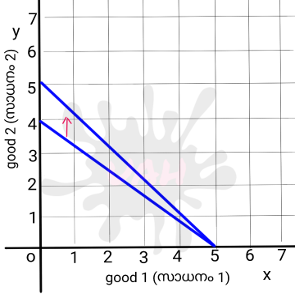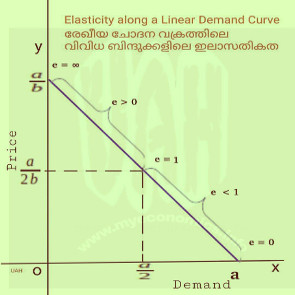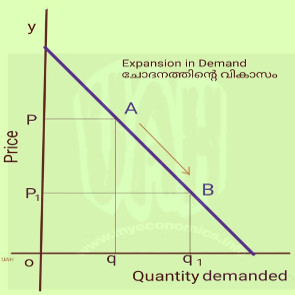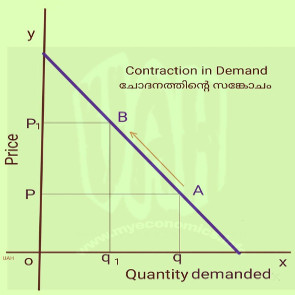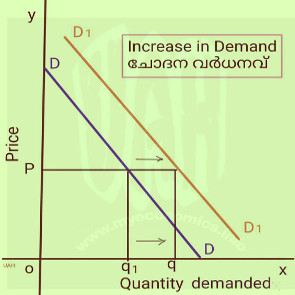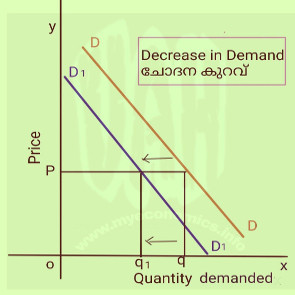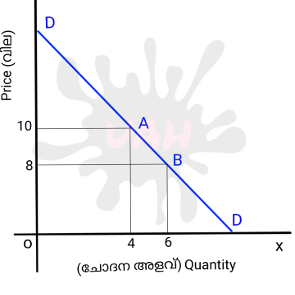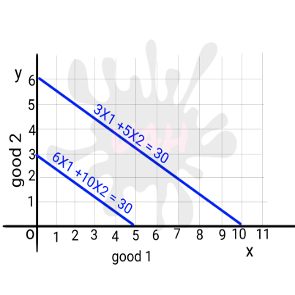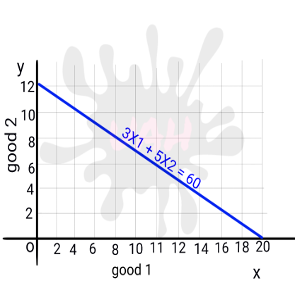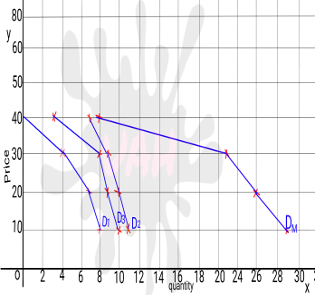Chapter 2 – Theory of Consumer Behaviour.
Questions and Answers
Find the odd one out
- Tea and Cofee, Bread and Jam, Car and Petrol, Sugar and Tea
- Salt, Matchboxes, Shirt, Pin
- P 1 / P 2 , MOC, -X 1 / -X2 , MRS
- Group the following goods into two based on their elasticity is that is whether they have elastic or inelastic demand:
- Indifference curve approach is the contribution of ?
- JR.Hicks .
- PA Samuelson.
- Alfred Marshall.
- Lionel Robins .
- Which of the following regarding the properties of IC true ?
- Convex to origin
- Negative slope
- IC curves never intersects each other
- Higher ICs shows higher level of satisfaction
- All of these.
- What is the slope of the budget line if, price of good 1 is ₹10 and price of good 2 is ₹5 ?
- 10
- 0.5
- -2
- 5
- Which of the following is the most important determinant of demand?
- Price
- price of related good
- Income
- Tastes and preferences
- Consider the equation y = f (x), then the variable Y is?.
- Exogenous
- Independent variable
- Dependent variable
- None of these
- What is the price elasticity of demand if, there is no change in expenditure as a result of change in price ?
- Unitary
- Elastic
- Inelastic
- Zero
- A fall in the price of a commodity, holding everything else constant, results an increase in demand and is referred to as ?
- Expansion in demand
- Contraction in demand
- Decreasein quantity demanded
- Increase in quantity demanded
- Which of the following goods has more elastic demand ?
- Rice
- Computer
- Electricity
- Life saving medicines
- Identify the nature of demand curve when elasticity of demand is equal to 1 ?
- Perfectly elastic demand
- Rectangular Hyperbola
- Parallel to Y axis
- Parallel to X axis
- In drawing an individual demand curve, all but one of the following are kept constant ?
- Price of the commodity
- Prices of related commodities
- Income of the consumer
- Tastes and preferences of the consumer
- Suppose a consumer’s preferences are monotonic, which among the following bundles consumer will not select ?
- ( 12, 11 )
- ( 15, 15 )
- ( 13, 14 )
- ( 12, 15 )
- Slope of a IC is represented by ?
- Price ratio
- DMU
- DMRS
- None of these.
- Identify the commodity, if demand for good y increases as a result of decrease in price of good x ?
- Substitutable good
- Normal good
- Inferior good
- Complimentary good
- In the given equation q= a-bp, slope is represented by?
- a
- -bp
- -b
- q
- In case of inferior good the relationship between income and demand will be ?
- Negative
- Positive
- Constant
- Can’t define
- Elasticity in a rectangular hyperbola type demand curve will be ?
- 1
- -1
- 0
- >1
- What is called if demand increases as a result of decrease in price ?
- Increase in demand
- Decrease in Demand
- Expansion in demand
- Shift of demand
- Price of a commodity increased from 10 to 15, as a result quantity demanded decreased from 100 to 75. What is the value of elasticity?
- 0.5
- 5
- 1
- 5.5
- When price of commodity x increases , the demand for commodity y increases. What is the nature of commodity x and y ?
- Complimentary Commodity
- Substitutable Commodity
- Inferior Commodity
- Luxury Commodity
- When the income of the consumer was ₹500, he buys 4kg of good y. His income increased by ₹100, then he reduced the consumption of good y by 2 units. What is the type of good y ?
- Substitutable good
- Luxury good
- Inferior good
- Complimentary good
- Want satisfying power of a commodity is called ?
- Demand
- Utility
- Value
- Budget
- The name given to the commodities using together ?
- Complimentary goods
- Substitutable goods
- Inferior goods
- Superior goods
- Mr. A consumes two fruits : Apple and Orange. He has monotonic preference, which implies that:
- He prefers a bundle with more apple and orange
- He prefers a bundle with less quantity of both the fruits
- He prefers a bundle with more of atleast one of the fruits and no less of the other
- He prefers no specific bundle
- Pick out the correct equation for showing consumer’s budget constraint ?
- P1X1 + P2X2 = M
- P1X1 + P2X2 ≤ M
- P1X1 + P2X2 ≥ M
- P1X1 + P2X2 > M
- Check whether the following statements are correct.
- The slope of indifference curve shows MRS between two inputs
- Higher indifference curve shows higher level of satisfaction.
- Indifference curves are concave to origin.
- Price and quantity demanded are positively related.
- Consumer gets maximum satisfaction when IC curve is tangent to Demand curve.
- The mid point of a linear demand curve which touches either axis, has 0 elasticity.
- If price and expenditure move in the same direction elasticity is more than one.
- Categorize the following goods in to substitutables and complimentaries.
- To buy sugar and tea Raju has ₹100 and Ravi has ₹75. Find budget of both consumers.
- Write suitable economic terms.
- The power of a commodity to satisfy human wants.
- A collection of indifference curves
- What is the elasticity at ₹3 in the linear demand equation q = 20 – 2p ?
- P1X1 + P2X2 ≤ M is a budget constrain. Identify the constraints ?
- Given the diagram. Identify the following.
- AB line.
- Point E.
- Elaborate the properties of indifference curve.
- In the diagram, point C and D does not represents equilibrium.? Do you agree with this? Explain.
- AB represents Budget Line.
- Point E represents equilibrium.
- Properties of indifference curve.
- ICs are negatively sloping.
- Higher indifference curve represents higher level of satisfaction.
- Indiffrence curve never intersects each other.
- Indiffernce curves are convex to origin.( This is because of goods in the x axis and y axis are not a perfect substitute and because IC curve never touches x axis or y axis.)
- Point C and D does not indicates equilibrium. Because, in order to reach equilibrium two conditions must be satisfied. First, IC should be tangent to budget line or Marginal Rate of Substitution (MRS) of good 1 for good 2 must be equal to price ratio of the two goods. The second condition is that IC must be convex to the origin at the point of tangency.
- Ravi is a agricultural labourer. If he spends his entire daily wages he can buy 4kg of rice and 2 kg of fish. The price of rice is ₹15 per kg. and the price of fish is ₹50 per kg. Find Ravi’s daily wage.
- A consumer wants to consume two goods. The prices of two goods are ₹4 and ₹5 respectively. If consumer’s income is ₹20, answer the following questions:
- Write down the equation of budget line.
- How much good 1 that the consumer can consume if he spends his entire income on good 1 ?.
- How much good 2 that the consumer can consume if he spends his entire income on good 2 ?
- What is the slope of budget line ?
- How does the budget line change if the consumer’s income increases from ₹20 to ₹40 but prices of two goods remain the same ?
- Show the change in budget line if the price of good 2 decreases by ₹1 but the price of good 1 1 and consumer’s income remains unchanged.
- P1X1 + P2X2 = M
Where ,
P1 = price of X1
P2 = price of X2
X1 = quantity of good 1
X2 = quantity of good 2
M = Income of the consumer
- $$ {\frac{M}{P_1} = \frac{20}{4} = 5} $$
- $$ {\frac{M}{P_2} = \frac{20}{5} = 4} $$
- $$ {\frac{-P_1}{P_2} = \frac{-4}{5} = -0.8} $$
- When income of the consumer increases without any changes in the price then budget line shifts parallel upwards to the earlier budget line. This movement is shown in the below given diagram.
- When only the price of good 2 decreases the budget line changes upwards in the good 2 axis. In the given diagram the interception on y axis changed from 4 to 5 while interception on x axis remained as 5.
- Categorise the following based on whether the law of demand is applicable or not applicable.
- The price of good X was ₹10 per unit and the quantity demanded was 500 units. Then, the price increased to ₹15 per unit, but the quantity demanded remained unchanged at 500 units. Calculate the price elasticity. Which degree of elasticity is this ? Draw a demand curve to show the elasticity.
- Usually a budget line slopes downwards from left to right. State any three reasons for the downward slope of the budget line.
- A country’s exports have elastic demand and its imports have inelastic demand. Will foreign trade be favourable or unfavourable to this country ? Justify your answer.
- Imagine that you are the financial minister of India. You want to raise more taxrevenue. How will you use price elasticity of demand in your tax proposals ?
- Consider the following figure: Why is point E in the figure considered as “consumer’s optimum / equilibrium” ? Justify your answer.
- IC should be tangent to budget line or Marginal Rate of Substitution (MRS) of good 1 for good 2 must be equal to price ratio of the two goods..
- IC must be convex to the origin at the point of tangency.
- Using the budget line equation 2x1 + 5x2 = 20 find the horizontal and vertical intercepts and draw the budget line.
- Given the level of income and market prices the rational consumer wants to attain the maximum level of satisfaction. Using the budget line and indifference curve that yiu have studied, answer the following questions.
- Construct a diagram showing the consumer’s equilibrium.
- What condition is satisfied under this equilibrium point ?
- A few goods are given below. State whether the demand for the product is elastic or inelastic. Justify your answer.
- From the budget line shown below, find the price of good x2 given that the price of good x1 is ₹30. The equation on the budget line is given as P1X1 + P2X2 = 1500.
- The price of a good remains constant throughout the year 2019. But a household’s demand for the commodity increased to 300 units in December from 200 units in other months. What conclusions can you derive from this ?
- The price of Jowar declined from ₹5 to ₹4 per kg. Concequently the quantity demanded declined to 2kg from 6kg. What conclusions can you derive from this ?
- The price of commodity y fluctuated in every month of 2019. But the quantity demanded stagnated at 100 units a month. What conclusions can you derive from this ?
- Due to an increase in the production of Onion, price decreased from ₹40 to ₹20.Concequently the market demand rises from 1000 kg to 3000 kg. Calculate price elasticity. Which degree of elasticity is this ?
- Two diagrams related to demand are given below. What do they represent ?
- Observe three budget lines drawn below. If AB is the initial budget line , what causes the shift in budget line
- from AB to AB1
- from AB to A1B1
- The increase in the price of good 1.
- Decrease in the income of the consumer.
- Given two demand equations q1 = 20 – 2P and q2 = 30 – 4P . Find market demand equation (Qm).
- When the price of a pen decreased from ₹5 to ₹4 , its demand increased from 1000 to 150 units. Find the price elasticity.
- “Price elasticity of demand is different at different points on the linear demand curve”-prove this point diagramatically.
- Elasticity at point, where demand curve intersect on x axis will be zero (Ep = 0)
- Elasticity at point, where demand curve intersect on y axis will be infinite (Ep = ∞)
- On a linear demand curve , the middle point represents elasticity equal to 1( Ep = 1)
- Between middle point and the point where linear demand curve cuts x axis, elasticity will be less than 1 (Ep<1)
- Between middle point and the point where linear demand curve cuts y axis, elasticity will be greater than 1 (Ep>1)
- Explain changes in demand.
- Expansion in demand
- Contraction in demand
- Increase in demand
- Decrease in demand
- Calculate the price elasticity of demand from a movement from point A to B on the demand curve DD.
- Let price of good 1 (PX1) = ₹3, price of good 2 (PX2) = ₹5, income of the consumer (M) = 30 and assume whole income is spend on good 1 and good 2.
- Construct the budget equation and the budget line.
- Suppose the prices of both good, good 1 and good 2, doubles, then what happens to the budget equation and budget line ?
- Suppose income of the consumer (M) doubles, then what happens to the budget equation and budget line ?
- From the below given diagram, find the point representing
- Monotonic preference
- Inferior bundle
- Indifferent bundle
- Point D
- Point E
- Points A, B, and C
- Observe the diagram.
- Comment on the given demand curve.
- Give any two reasons for the positional change of demand curve from from DD to D1D1.
- The above given diagram shows the shift in demand or increase in demand
- Increase in the income of the consumer, decrease in the price of other related good
- John, Jaffer and Janardhanan are 3 customers who purchased apples from market. Individual quantity demanded for mangoes are given in the schedule .
- Construct market demand schedule
- Draw market demand curve
- Based on the given schedule, identify the nature of good (Hint: Normal, inferior, giffen)
Answer :
Tea and Coffee,others are complimentary goods.
Answer:
Shirt, others are inferior goods.
Answer :
MOC, others represents slope of the curve.
Tomatoes, Mangoes, Medicines, Garments, Mercedes Benz Car, salt.
Answer:
| Elastic. | Inelastic. |
|---|---|
| Tomatoes | Medicines |
| Mangoes | Mercedes Benz Car |
| Garments | Salt |
Answer:
A. JR Hicks
Answer :
E.All of these
Answer :
C. -2.
Answer :
A. Price
Answer :
C. Dependent variable.
Answer :
A. Unitary
Answer:
A. Expansion in demand
Answer:
B. Computer
Answer :
B. Rectanguular Hyperbola
Answer :
A. Price of commodity
( 15, 15 ), ( 13, 14 ), ( 12, 12 ), ( 12, 11 )
Answer:
B. ( 15, 15 )
Answer:
C. DMRS
Answer :
D. Complimentary good
Answer :
C. -b
Answer :
A. Negative
Answer :
A. 1
Answer :
C. Expansion in demand
Answer :
A. 0.5
Answer :
B. Substitutable commodity
Answer :
C. Inferior good
Answer :
B. Utility
Answer :
A. Complimentary goods
Answer :
C. He prefers a bundle with more of atleast one of the fruits and no less of the other
Answer :
B. P1X1 + P2X2 ≤ M
Answer :
False (The slope of indifference curve shows MRS between two goods)
Answer :
True
Answer :
False (Indifference curves are convex to origin)
Answer :
False (Price and quantity demanded are negatively related)
Answer :
False (Consumer gets maximum satisfaction when IC curve is tangent to budget line)
Answer :
False (The mid point of a linear demand curve which touches either axis, has elasticity equal to 1)
Answer :
False (If price and expenditure move in the same direction elasticity is less than one)
Pen and Ink, Bread and Jam, Car and Petrol, Flight and Train, Coffee and Tea, Shoes and Sandals.
Answer :
| Complimentaries | Substitute |
|---|---|
| Pen and Ink | Coffee and Tea |
| Car and Petrol | Flight and Train |
| Bread and Jam | Shoes and Sandals |
Answer :
The budget of Raju is ₹100 and budget of Ravi is ₹75.
Answer :
Utility
Answer :
Indifference maps
Answer :
Given, q = 20 – 2P
Here use the equation of priceelasticity of demand as, $$ {ed =\frac{-bp}{a-bp}} $$
where , b = 2, a = 20, P = 3
∴ $$ {ed =\frac{-2 × 3}{20-(2 × 3) } = \frac{-6}{20-6}} $$ $$ { =\frac{-6}{14}} $$ $$ { = -0.42} $$
$$ { ed < 1} $$
Answer :
P1, P2, M
Answer :
Answer :
Total expenditure incurred by Ravi:P1X1 + P2X2 = M 15 x 4 + 50 x 2 = 60 + 100 = 160 Ravi's daily wage is ₹160.
Answer :
Fish, Oranges, Luxury cars, Vegetables, Life saving medicines, Diamonds.
Answer :
| Law of demand is applicable | Law of demand is not applicable |
|---|---|
| Oranges | Luxury cars |
| Fish | Life saving medicines |
| Vegetables | Diamonds |
Answer :
ΔP = Change in price = 15 - 10 = 5 ΔQ = Change in quantity. = 500 - 500 = 0 P = Base price = 10 Q = Base quantity = 500$$ {ed =\frac{ΔQ}{ΔP} × \frac{P}{Q}} $$ $$ { =\frac{0}{5} × \frac{10}{500}} $$ $$ { = 0} $$
$$ { ed = 0} $$ ∴ that is perfectly inelastic demand.
The demand curve will be parallel to y axis..
Answer :
The slope of the budget line measures the rate at which the consumer is able to substitute good 1 for good 2 (rate of substitution). It slopes downward because the consumer desire is limited. So he/she cannot consume more of both the goods. He/she has to reduce the consumption of one good to minimise the consumption of the other. It is measured by price ratio, that is -P1/P2. Price ratio will be negative, so the budget line will slope downward.
Answer :
It will be unfavourable. Import cost will be high due to inelastic demand. Export earning will be low ; since price of export goods can not be raised.
Answer :
The finance minister wants more revenue. this is possible when taxes are raised or imposed on goods with inelastic demand.
As a finance minister I will raise taxes on goods like cigarattes, liquor and luxury products. These goods have inelastic demand. Therefore their demand will not be affected by raising tax. This will help to raise more tax revenue.
I will reduce taxes on goods with elastic demand. Concequently, their price will decline resulting an increase in demand. This will also raise tax revenue.
Answer :
The above given diagram shows the consumer equilibrium as per the indifference curve analysis. Here point E is considered as equilibrium point, here he can get maximum level of satisfaction. When the indifference curve is tangent to the price line, the consumer is in equilibrium. Here at point E both line are tangents to each other. At point E, slope of IC (MRS) = the slope of price line (-p1 / p2)
Conditions for equilibrium :-
Answer :
Given the budget line equation = 2x1 + 5x2 = 20
Horizontal intercept (x1)
$$ {=\frac{M}{P_1} = \frac{20}{2} = 10} $$
Vertical intercept (x2)$$ {=\frac{M}{P_2} = \frac{20}{5} = 4} $$
The budget line is shown below :
Answer :
The optimum bundle is located on the budget line at the point where the budget line is tangent to an indifference curve. The IC just touching the budget line is the highest possible indifference curve given the consumer’s budget set. Bundles on the IC below the budget line are inferior. Bundles on the IC above the budget line are not affordable to the consumer.The point (x*1, x*2), at which the budget line is tangent to an indifference curve represents the consumer’s optimum bundle.
Rice, Car, Matchbox, Life saving medicines, T.V, Electricity, Tea, Kerosene.
Rice – Inelastic. This is because this is an essential good.
Car -Elastic. This a luxurious good, so change in price will not affect.
Matchbox– Elastic. This an example for inferior good, so change in price affects its demand.
Life saving medicines – Inelastic. The buying of this type of commodity can not be postponed, so that price will not affect its demand.
T.V – Elastic demand. T.V is not an essential good, so change in price affects its demand.
Electricity – Inelastic. There is no close substitute for this product, so change in price will not affect its demand.
Tea– Elastic demand. Tea is a substitutable good , so the change in price causes for change in demand.
Kerosene – Elastic demand. Comparatively kerosene is an inferrior product. So there will be elasticity in demand.
Answer :
Here on x axis we take quantity of good 1 and on y axis qauntity of good 2, X1 = 40 and X2 = 30
$$ P_2 {=\frac{300}{30} = 10} $$P1X1 + P2X2 = 1500
30 × 40 + P2 × 30 = 1500
1200 + 30P2 = 1500
30P2 = 1500 - 1200 = 300
Answer :
This is a case of shift (increase) in demnad. The increase in demand might have been caused by factors like increase in income of the consumer, change in price of related commodity or change in taste and preference.
Answer :
There is a direct relationship between price of jowar and its quantity demanded. So Jowar is an inferior good.
Answer :
The demand for commodity y is price inelastic. This is a case of prerfectly in elastic demand.
Answer :
ΔP = Change in price = 20 - 40 = 20 ΔQ = Change in quantity = 3000 - 1000 = 2000 P = Base price = 40 Q = Base quantity = 1000$$ {ed =\frac{ΔQ}{ΔP} × \frac{P}{Q}} $$ $$ { =\frac{2000}{20} × \frac{40}{1000}} $$ $$ { = 4} $$
$$ { ed >1} $$ ∴ It is Elastic demand or ed > 1.
Answer :
1- Movement along the demand curve due to change in price.
2- Shift of demand curve due to change in non-price factors.
Answer :
Answer :
e have , q1 = 20 - 2P, q2 = 30 - 4P Market demand equation Qm = q1 + q2 That is, Qm = (20 - 2P) + (30 -4P) = 20 + 30 - 2P + 4P Qm = 50 - 6P
Answer :
ΔP = Change in price = 5 - 4 = 1 ΔQ = Change in quantity = 100 - 150 = -50 P = Base price = 5 Q = Base quantity = 100$$ {ed =\frac{ΔQ}{ΔP} × \frac{P}{Q}} $$ $$ { =\frac{-50}{1} × \frac{5}{100}} $$ $$ { = -2.5} $$
$$ { ed >1} $$ ∴ Elastic demand.
Answer :
Answer :
Change in quantity demanded due to change in price leads to expansion and contraction in demand. In this case, there is the movement along the demand curve. This happens in two way.
Increase in demand due to decrease in price is called expansion in demand. Here the increase in demand is expressed as the downward movement along the demand curve from point A to B. Quantity demanded increased from q to q1 as a result of decrease in price from P to P1.
Decrease in demand due to increase in price is called contraction in demand.Here the decrease in demand is expressed as the upward movement along the demand curve from point A to B. Quantity demanded increased from q to q1 as a result of decrease in price from P to P1.
Change in quantity demanded as a result of favourable or unfavourable change in factors other than price will lead to an increase or decrease in demand. In this case, there is a shift of demand curve in two ways.
A favourable change in factors other than price (Eg. In the rainy season demand for rain coat will increase, this increase in demand is due to favourable change in climate and not by decrease in price) will increase demand. In the below given diagram, the price P remains the same where as quantity demanded increases from q1 to q. The shift of demand curve DD to D1 D1 is called increase in demand.
An unfavourable change in factors other than price (Eg. In the summer season demand for rain coat will decrease, this decrease in demand is due to an unfavourable change in climate and not by increase in price) will decrease demand. In the below given diagram, the price P remains the same where as quantity demanded decreases from q to q1. The shift of demand curve DD to D1 D1 is called decrease in demand.
Answer :
Here, ΔP = 2 ΔQ = 2 P = 10 Q = 4$$ {ed =\frac{ΔQ}{ΔP} × \frac{P}{Q}} $$ $$ { =\frac{2}{2} × \frac{10}{4}} $$ $$ { = 2.5} $$
$$ { ed >1} $$ It indicates elastic demand.
1. 3X1 + 5X2 = 30
2. The budget equation 3X1 + 5X2 = 30 changes as 6X1 + 10X2 = 30 as a result budget line shifts leftward from the original budget line. It is shown in the below diagram.
3. If income of the consumer (M) increases the budget line equation 3X1 + 5X2 = 30 changes to 3X1 + 5X2 = 60. So the budget line will shift rightward from the original budget line . It is shown in the below given diagram. In the diagram, vertical and horizontal intercepts changed.

Answer :
| Price | D1 | D2 | D3 |
|---|---|---|---|
| 10 | 8 | 11 | 10 |
| 20 | 7 | 10 | 9 |
| 30 | 4 | 9 | 8 |
| 40 | 0 | 5 | 3 |
1.
| Price | D1 | D2 | D3 | Dm |
|---|---|---|---|---|
| 10 | 8 | 11 | 10 | 29 |
| 20 | 7 | 10 | 9 | 26 |
| 30 | 4 | 9 | 8 | 21 |
| 40 | 0 | 5 | 3 | 8 |
3. This is a normal good.
![]()




